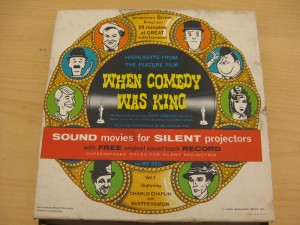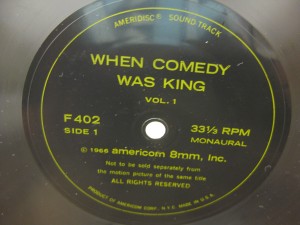sound on disc
September 7th, 2009
In the young days of cinema, one of the first methods for presenting a film with recorded sound was to employ a method of sound on disc. In the mid-1920s, films were occasionally distributed with an accompanying record. The projector for this type of presentation had a record player attached to the base, and the record and film would be synched up by the projectionist. As one might imagine, the synch didn’t always work, sometimes the record would skip or perhaps the operator would put on the wrong record. It wasn’t a perfect system.
In the later 1920s, sound on film, which was a system that had been simmering for a few years, broke through and changed popular cinema forever, effectively killing the silent feature film. This technique of sound on film, still in use today, provides an optical soundtrack on the edge of the film, which means it never goes out of synch (unless there has been a mix-up in the production of the track) as well as avoiding other problems of sound on disc.
Sound on disc made a brief re-appearance in the 1990s with the introduction of the digital sound on CD format, DTS. In this format, the 35mm print was released with an optical soundtrack as well as digital track on CD. To use this system, there would be a time code reader on the projector that read an optical timecode on the film (see below), which kept the CD track in synch with the picture. As with other theatrical digital formats, the analogue optical soundtrack is retained, and in case of failure of the digital sound, the projector can revert to the optical soundtrack.
This image, below, from Kill Bill (Tarentino, 2003), shows the 4 modern soundtracks. The left side of the film shows two digital tracks, Sony’s blue SDDS on the outer edge of the perforations, Dolby’s black digital information between the perforations, and to the right of the perforations, the two white lines of analogue optical soundtrack (variable area), and the DTS optical timecode (white vertical dashes to the immediate left of the image), which is used to keep the CD in synch with the picture.

I discovered today, while working with the Burr Collection, that sound on disc found its way to the home movie market as late as 1966. The 8mm film pictured below, perhaps not surprisingly, is a compilation film from the 1920s/1930s when cinema’s comedians were coming out of a career in vaudeville.

8mm sound on disc
The record provided with this film could be played on standard record player, but it is a flexi-disc, the cheapest of disc recordings. This type of record could also be found in magazines as an advertisement or free song.


